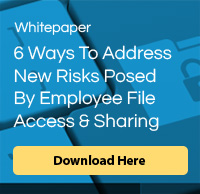 Enterprises have invested heavily into enterprise content management (ECM) solutions.
Enterprises have invested heavily into enterprise content management (ECM) solutions.
ECM facilitates a means for users to share and collaborate on enterprise files, and for IT departments to store and control corporate content while managing compliance requirements.
To meet workforce productivity demands in the current mobility world, enterprises must increasingly offer anytime, anywhere, any device access to corporate files stored in these ECMs.
What’s the best way to provide file-sharing flexibility without compromising on enterprise file security? Here are three essentials for seamless, secure enterprise content management in a mobile-friendly environment.
- Integrate ECM with enterprise file sync & share (EFSS) to extend secure file access to mobile devices: With so many effective mobile apps and consumer-grade solutions designed to make the workday productive, end users have high expectations.
If you don’t provide mobile productivity solutions, expect users to find alternative methods to accomplish their goals. By providing a secure and easy-to-use platform for accessing, sharing and collaborating on files from a mobile device, users are less likely to circumvent your efforts and turn to unsecure solutions.
Moreover, many large enterprises have already invested significant resources into ECM platforms such as SharePoint, Documentum, Alfresco or OpenText. Instead of scrapping the existing ECM foundation, it’s better to extend secure access to the ECM system through mobile devices. Look for an EFSS solution that plugs into your existing ECM platform to facilitate secure, mobile file access, sharing and collaboration. - Leverage enterprise digital right management (DRM) to secure information with third parties: With all the collaboration and information exchange that happens between an enterprise and third parties, IT departments must be vigilant about preventing their information from falling into the wrong hands.
Controlling your data as it moves beyond the corporate network is essential, and enterprise DRM helps IT teams define how much access and control any user has over an enterprise file. For instance, if you’re sending sensitive information to your company’s insurance agent, you might only want it to be viewable for a few days. With enterprise DRM, you can set policies that disable viewing rights after a set time, while also controlling functions such as copy/paste, print and screenshots. - Open up your ECM platform to secure BYOD: The booming bring-your-own-device (BYOD) trend is challenging the old-guard belief that secure file access is only possible through a secure device. As more end users access and manipulate enterprise data from their personal laptops and mobile devices, the prospect of securing all those devices becomes too daunting.
Instead, focus on securing the enterprise data on those devices, rather than the device itself. Look for an EFSS solution that provides Mobile Content Management (MCM). If end users already use your ECM to access enterprise content, encourage them to continue doing so as your organization transitions to BYOD. By administering secure access controls, MCM, DRM and secure EFSS to enterprise files on the ECM platform, BYOD becomes safer and less troublesome.
While you shouldn’t take protecting your enterprise files from threats presented by the mobile world lightly, don’t view it as an unbeatable challenge.
Robust, secure enterprise file sharing tools are available to essentially extend the dimensions of current ECM platforms, creating an environment of secure file access, sharing and collaboration for end users regardless of where they’re located or what device they’re using.
As the world continues to change, your organization must take a proactive approach to the challenges that mobility presents to enterprise file security. Start by finding ways to integrate the most important enterprise file security features into your existing ECM platform.
